I have several friends who currently own Rhodesian ridgebacks who originally considered getting a vizsla when they were researching dog breeds. I can see why this is a common occurrence: both have sleek, athletic bodies and short rust-colored coats. They were both bred for endurance and hunting. Runner’s World Magazine rates vizslas and ridgebacks as good dogs for running. But as an owner to both of these breeds, I can tell you that they are very, very different. When considering a vizsla vs ridgeback, what should you know?
History Matters
The original purpose of these dogs is one of the main keys to understanding their differences. Vizslas were originally bred in Hungary to hunt upland game such as quail, pheasant, partridge. That meant they were out in fields, running for miles and miles. Their human companions were often on horseback, so the dogs were going fast. They worked with the hunter, running, pointing and retrieving game. They were owned by aristocrats and royalty and were always allowed to be inside the home with their owners. There’s an old Hungarian saying that describes their “velcro” tendency: “If you own a Vizsla, it lives on top of your head.”
Rhodesian ridgebacks, on the other hand, were bred in Zimbabwe to hunt and keep large game, such as lions, at bay until a hunter could arrive and kill the animal. The ridgebacks hunted in packs, and went out ahead of the hunter to track and find game. Since they were hunting such large animals, I imagine this was not an every day occurrence. They were also used as guard dogs to protect people’s homes and property. Guarding property means a lot of sitting and laying around, watching and listening for strange creatures and noises.
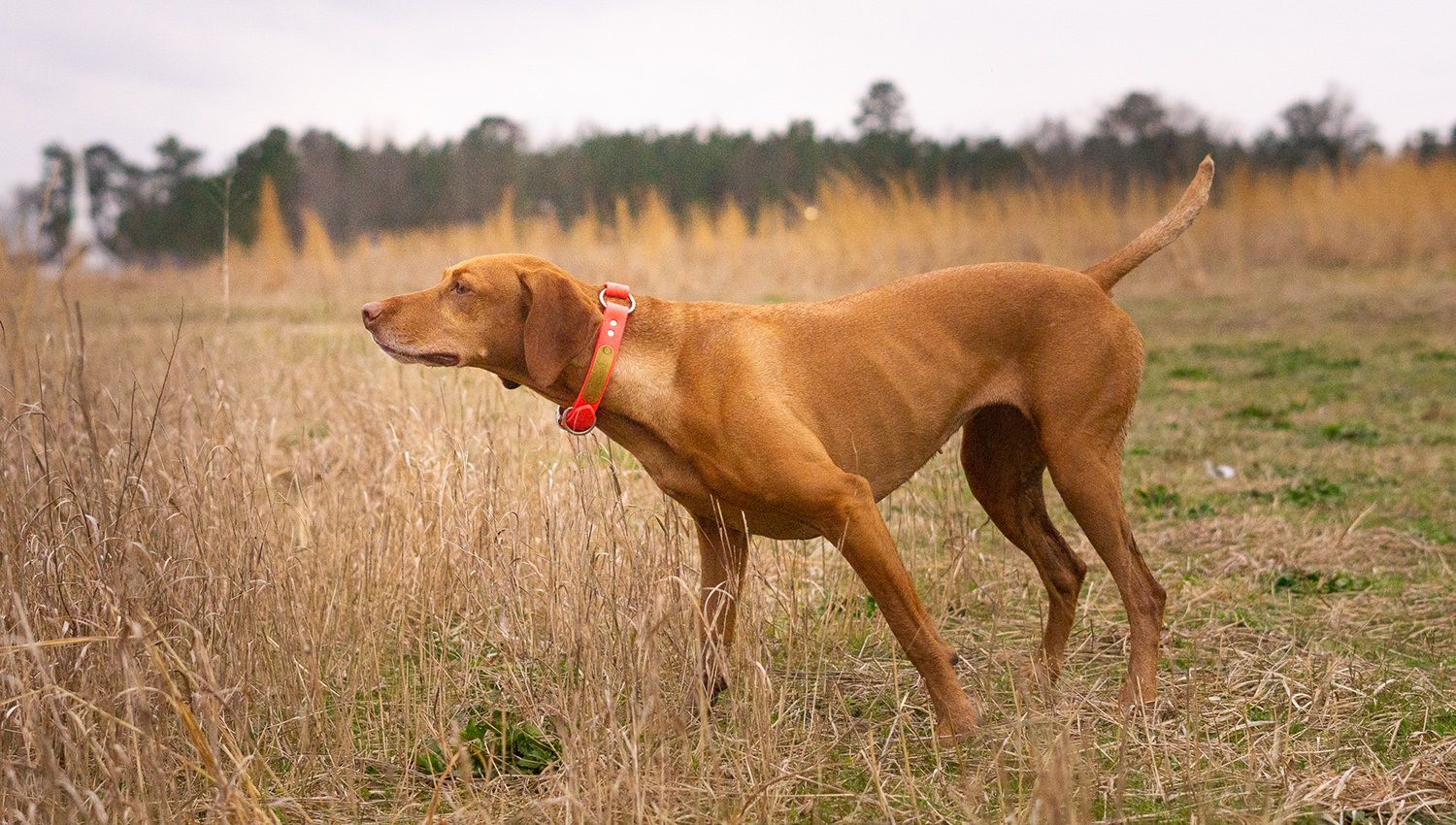
Zara points a bird. There is nothing that she loves more than hunting birds. There’s also nothing that tires her out more.

Maybe this is what it looks like when a pack of ridgebacks keeps a lion at bay. :)
Exercise Needs
This ancestry means that vizslas need lots and lots of off-leash exercise. A dog that was bred to hunt for hours a day is not content with a 30 minute stroll around the block. If you are considering a vizsla, I’d suggest going to watch a young one (one to two-year-old) run around off-leash for an hour or so. They never stop moving. When we used to take Zara to the dog park a lot, people would always be shocked at the speed at which she could hurtle herself at a ball. According to various online sources, vizslas are the one of the fastest dog breeds.
Hunting requires a lot of mental effort and if a dog is not getting this outlet on a regular basis, then they need a lot of mental exercise as well, which means training games, scentwork, and teaching tricks. However, training a vizsla for hunting or hunting competitions can be a wonderful way to spend time with your dog, as I have discovered. It’s worth considering, even if you don’t have any experience with it. That’s what happened to me and I don’t regret a second of it.
Ridgebacks also need exercise, but they do not require the same level. They can be content with daily walks and an off-leash romp once or twice a week. Ridgebacks are more adaptable in this area. Last year, we trained for and completed the 12-mile Endurance Trial at the Rhodesian Ridgeback Club of America’s National Specialty. Colombo finished this event with energy to spare. They certainly can tolerate and thrive with this level of exercise. Most days, though, he’s content with a half-hour walk or hike in the evening and will sleep the majority of the day and evening. Frankly, ridgebacks can be downright lazy. I don’t think anyone would ever call a vizsla lazy.
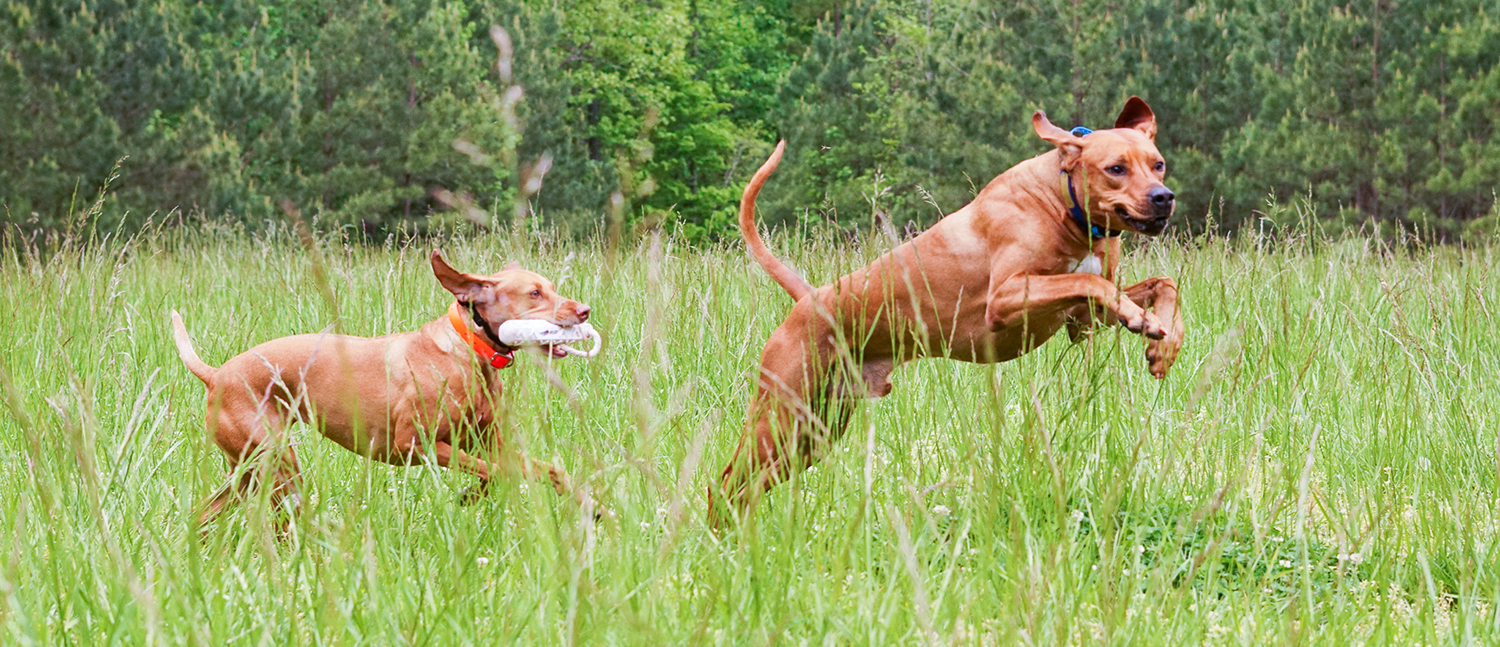
Both Zara and Colombo enjoying running and playing off-leash, but Zara needs much more of it than Colombo does.
Emotional Needs
In general, vizslas are considered needy dogs and have “soft” temperaments. They do not enjoy being left alone and they want to be sitting next to you if you’re on the couch. People who love the vizsla breed find this quality endearing, but others may find it maddening. Ridgebacks can also be sensitive but they are not quite as soft. Both breeds are known for following their owners around the house and not letting them go to the bathroom alone.
Play Style
Ridgebacks are known for their rough, wrestling style of play that can look aggressive if you are not used to it. They often vocalize while playing with strange, dinosaur-type sounds. This play style can also be off-putting to other kinds of dogs. Last spring, we watched our friends’ ridgeback Hudson for a month while they were on their honeymoon. Every day, it seemed like Colombo and Hudson were trying to purposefully get injured. When we’d be in our bedroom, one of them would get on the bed and take a flying leap, landing directly on the other one. Instead of being angry, it would just energize the other one more. Cue more open mouth wrestling and dinosaur sounds.
Vizslas, on the other hand, can wrestle too, but they’d usually prefer to run and chase each other and play with toys. Zara does not tolerate Colombo’s style of wrestling.
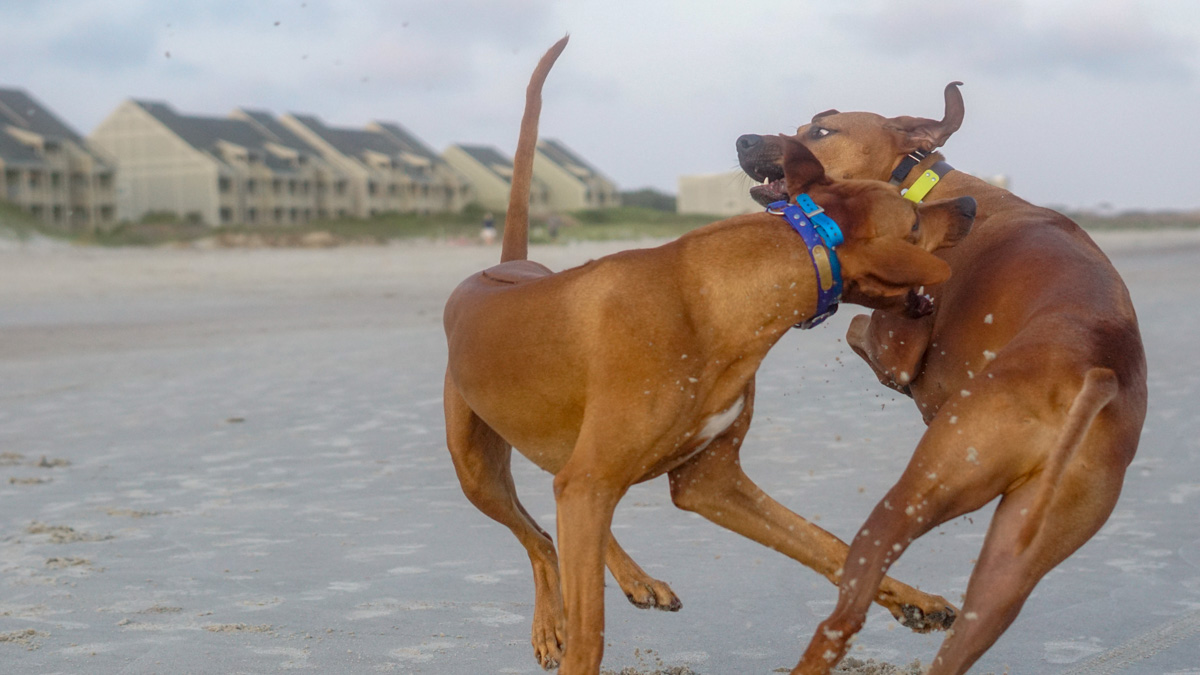
Typical ridgeback play
Trainability
Since vizslas were bred to work cooperatively with hunters, they naturally want to please and are easy to train. A lot of them also have a natural recall or ability to “check in” with their humans when they are off-leash.
Ridgebacks are hounds and were bred to hunt independently. Because of that, they are less willing to please. They often require more motivation. Luckily, most ridgebacks are very food-driven, so that helps a lot with training.

Zara loves to work and would retrieve bumpers all day long if I asked. Colombo will often think about it before he will do something for me.
Size
One very obvious difference between vizslas and ridgebacks is their size. Female vizslas are typically between 40 and 55 pounds and males are between 50 and 65 pounds. A female Rhodesian ridgeback, on the other hand, is usually around 70 pounds, and the standard for males is 85 pounds, but they can certainly be heavier. Colombo, for example, is 95 pounds and when we go to dog shows, he is not an abnormality.
This size difference is significant. An 85 or 95 pound dog is a lot of dog. Depending on how big of a person you are, a ridgeback can easily overpower you. When I’m walking Colombo on a leash and he sees a squirrel, I have to hold on tight. But this is also where training comes into play. It’s important to spend a lot of time training your ridgeback when he or she is young. This is important for any kind of dog, but especially for one that is so large. No one wants to deal with a disobedient, untrained ridgeback. A female vizsla, on the other hand, is fairly easy to scoop up and carry if needed.
Size is also something to think about when estimating how much you’ll be spending on your dog’s food. While vizslas are quite active and can require a lot of calories, you will likely spend more money feeding a ridgeback than a vizsla over the course of their lifetime.
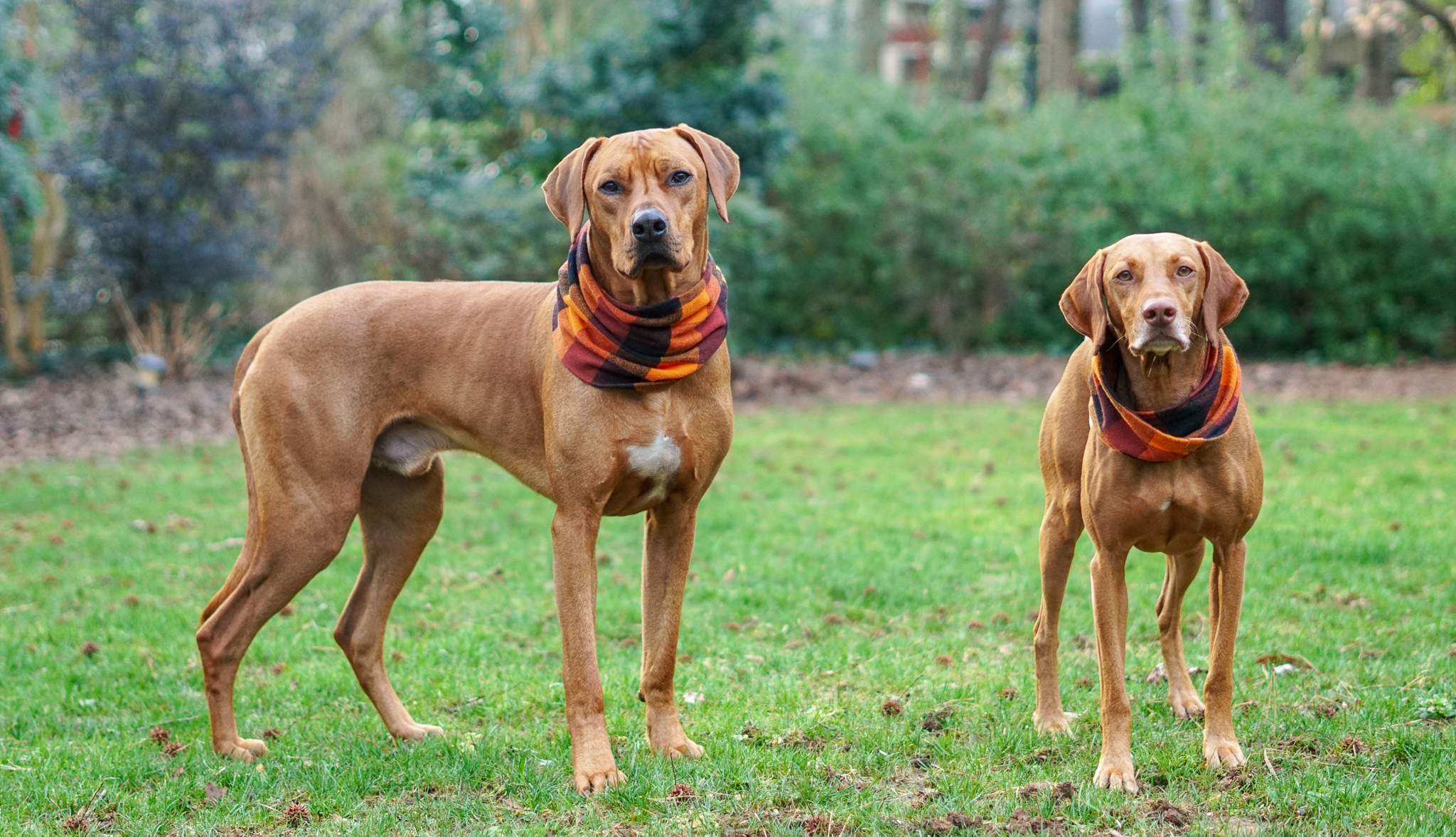
95 lb ridgeback vs 46 lb vizsla
Your Lifestyle
I think people who think of themselves as “active” can easily be convinced into thinking a vizsla is right for them. This was certainly the case with Chris and I. We ran about three miles three times a week, occasionally hiked and kayaked on the weekends, didn’t mind walking places, and had some extra time to devote to a dog. Sounds perfect, right? But this type of “active” lifestyle is not enough for a vizsla. It is, however, enough for a Rhodesian ridgeback.
I think the majority of active people who are looking for a dog companion are more suited to a ridgeback than a vizsla. People who have vizslas will often say that a vizsla is not a dog, it’s a lifestyle. However, if you are able to adjust your lifestyle (this is what I did) and can keep up with their exercise needs, than vizslas are lovely dogs: sweet, trainable, and willing to please.
Ridgebacks are easier to tire out physically, but because of their size and stubborn nature, can be a little more difficult to train. You need to be a strong leader, or a ridgeback will walk all over you. This is sometimes why breeders say ridgebacks are not always good for first-time dog owners. But if you are consistent and disciplined with your training and rules, then a ridgeback can be a great companion.
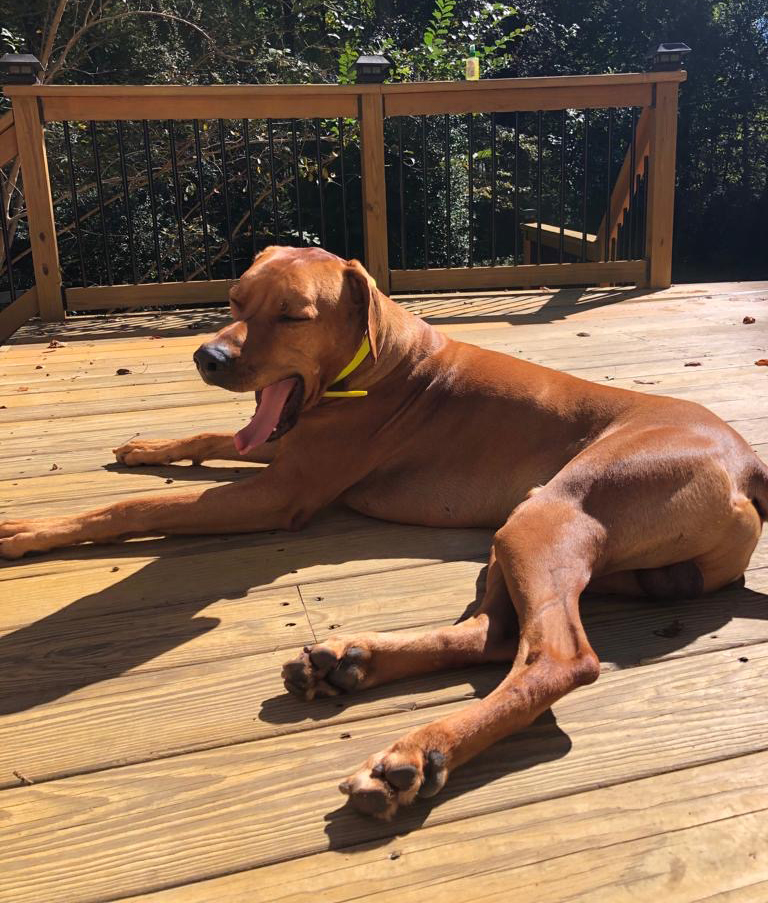
Colombo loves to sunbathe when he’s outside. Zara is always moving when she’s outside.
Which is Right For You?
Having both, it’s fun to see the differences between vizslas and ridgebacks. Even though they have different personalities and motivations, Zara and Colombo get along well and complement each other.
If you are considering one of these breeds, which one suits your lifestyle better?
Leave me a comment below!

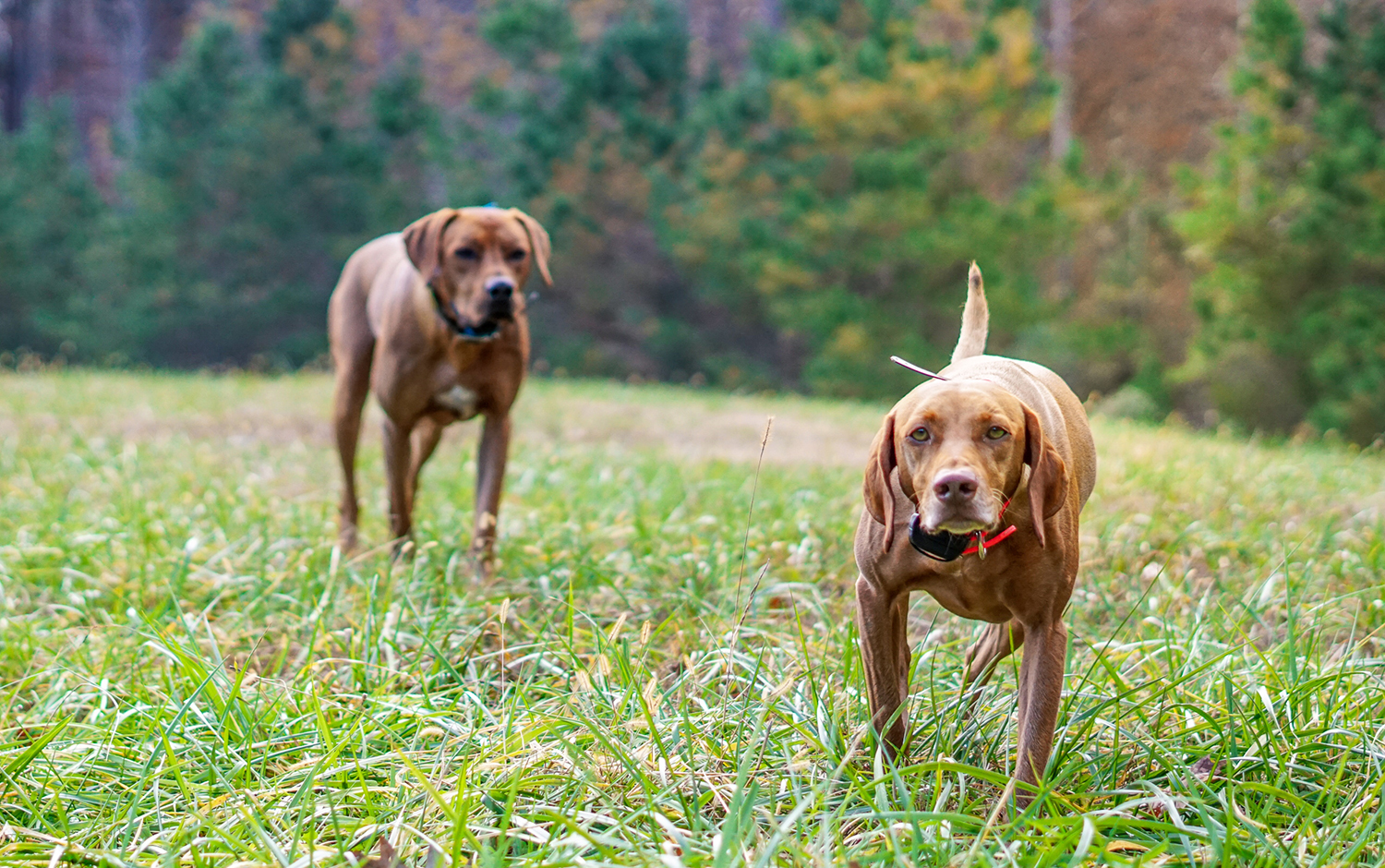






Daughter lives currently with us and brought home a Ridgeback, doing great with his training for a year and a half. I am considering a second dog and leaning strongly for a Vizsla. We live in an apartment in Phoenix, we don’t hunt but husband and I work from home, and I am looking for a running companion. I run and hike a lot, like 40-60 miles a week usually 10-14 hrs. Would something like that be enough exercise for a Vizsla? plus training and an evening walk? Do they handle heat well? dry heat below 100 F (thinking during Summers when I usually run from 5-7am and every other weekend tend to drive to Flagstaff for cooler weather for longer 3-5hrs runs in the mountains. Typically one rest day a week. Do they nap during the day? or constantly active looking for attention?I do need to work even if at home lol I really like the idea of a more affectionate and trainable, eager to please dog. Wonder if their pray drive is easy to control with training because we do have bunnies everywhere, lots of quail, I see coyotes regularly and ocasional javelinas and squirrels and if running off leash (which would be ideal for a Vizsla, could also be dangerous if sets off running after a Jack rabbit through the cactus with potential rattle snakes encounters worries me. I have been able to somewhat manage that with the Ridgeback and in general is really good but squirrels and Jack rabbits are huge triggers and needs to wear an ecollar for his safety for those 5% of times he doesn’t listen to a recall. Guess hoping the “Velcro” side of a Vizsla is stronger than the desire to chase.
Would a Vizsla be happy with the running and having the humans with her, playing fetch, training and sniffing games or nose work some times? I have crossed paths with runners with a Vizsla on trails and the dog didn’t even paid attention to us and just kept running off leash with the owners, my Ridgeback sometimes will react .. the other breed I was considering was a GSP but still doing research on them.
Sorry if this is too long!
Hi Gladys,
I’m sorry for the much-delayed response! It sounds like a vizsla could be a good option for you. Running that much is certainly enough. Keep in mind you shouldn’t run with a puppy until their growth plates close, which for a vizsla is anywhere from 1–2 years. They do chill during the day, although sometimes you have to teach them to settle. The “place” command is very useful, as is a crate. They can be needy, but again, you have to set expectations. As for prey drive, my vizsla is much easier to control than my ridgeback. They do both wear e-collars. With proper training starting when he/she is young, I think you’ll be fine. Obviously you need to be watching any time your dog is off-leash and things can happen. But training and tools like electronic collars go a long way. Good luck!
Terry Ann